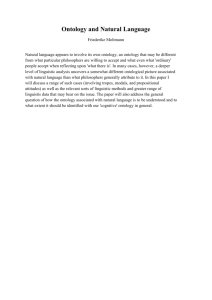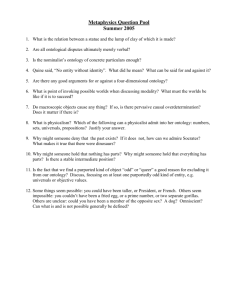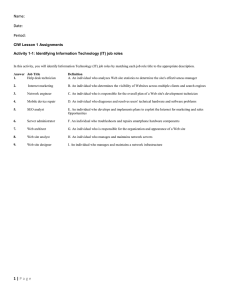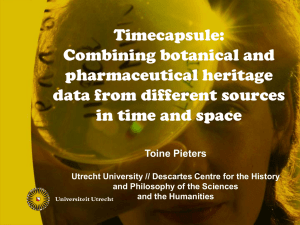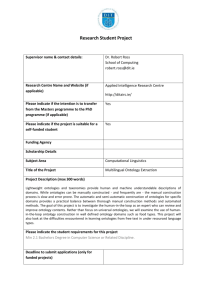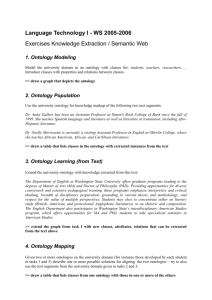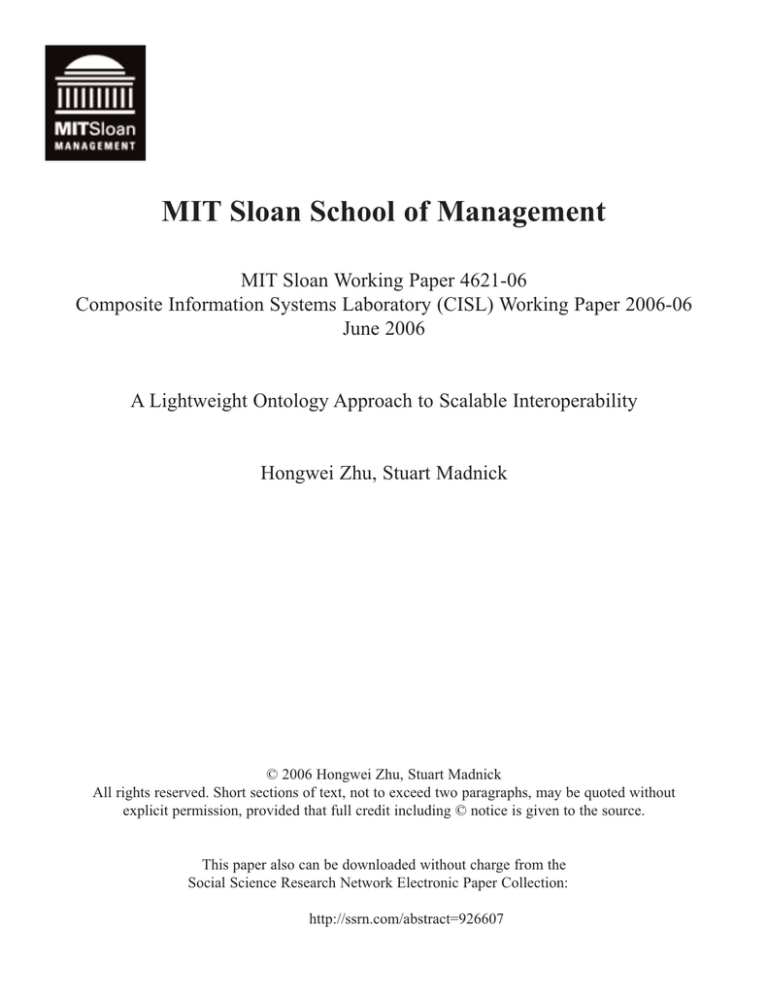
MIT Sloan School of Management
MIT Sloan Working Paper 4621-06
Composite Information Systems Laboratory (CISL) Working Paper 2006-06
June 2006
A Lightweight Ontology Approach to Scalable Interoperability
Hongwei Zhu, Stuart Madnick
© 2006 Hongwei Zhu, Stuart Madnick
All rights reserved. Short sections of text, not to exceed two paragraphs, may be quoted without
explicit permission, provided that full credit including © notice is given to the source.
This paper also can be downloaded without charge from the
Social Science Research Network Electronic Paper Collection:
http://ssrn.com/abstract=926607
A Lightweight Ontology Approach to
Scalable Interoperability
Hongwei Zhu , Stuart Madnick
Massachusetts Institute of Technology
Cambridge, MA USA
{mrzhu, smadnick}@mit.edu
Working Paper CISL# 2006-06
June 2006
Composite Information Systems Laboratory (CISL)
Sloan School of Management, Room E53-320
Massachusetts Institute of Technology
Cambridge, MA 02142
A Lightweight Ontology Approach to
Scalable Interoperability
Hongwei Zhu1, Stuart E. Madnick1
1
Massachusetts Institute of Technology,
30 Wadsworth Street, E53-320, Cambridge, MA 02142, USA
{mrzhu, smadnick}@mit.edu
Abstract. There are many different kinds of ontologies used for different
purposes in modern computing. Lightweight ontologies are easy to create, but
difficult to deploy; formal ontolgies are relatively easy to deploy, but difficult
to create. This paper presents an approach that combines the strengths and
avoids the weaknesses of lightweight and formal ontologies. In this approach,
the ontology includes only high level concepts; subtle differences in the
interpretation of the concepts are captured as context descriptions outside the
ontology. The resulting ontology is simple, thus it is easy to create. The context
descriptions facilitate data conversion composition, which leads to a scalable
solution to semantic interoperability among disparate data sources and contexts.
Keywords: lightweight ontology, context, mediation, scalability.
1 Introduction
Ontologies have been widely used in modern computing for purposes such as
communication, computational inference, and knowledge organization and reuse [5].
For different purposes, there are a variety of different ontologies that range from a
glossary, to a taxonomy, a database schema, or a full-fledged logic theory that
consists of concepts, relationships, constraints, axioms, and inference machinery. As
illustrated in [14], a variety of ontologies form a continuum from lightweight, rather
informal, to heavyweight, and formal ontologies.
The lightweight ontology approach and the formal ontology approach are often
used differently and have different strengths and weaknesses. Lightweight ontologies
usually are taxonomies, which consist of a set of concepts (i.e., terms, or atomic
types) and hierarchical relationships among the concepts. It is relatively easy to
construct a lightweight ontology. To use a lightweight ontology for interoperability
purposes, all parties need to agree on the exact meaning of the concepts. Reaching
such agreements can be difficult. The lightweight ontology and the agreements
together form a standard that all parties uniformly adopt and implement. That is, a
lightweight ontology is often used to support strict data standardization. In contrast, a
formal ontology uses axioms to explicitly represent subtleties and has inference
capabilities. It can support data standardization in a different way, that is, the
agreements are explicitly specified in the ontology. More often, a formal ontology is
1
used to allow for data heterogeneity and to support interoperability, in which case the
different interpretations and representations of data are explicitly captured in the
ontology. In either case, a formal ontology disambiguates all concepts involved. Once
created, a formal ontology can be relatively easy to use. But it often takes tremendous
effort to create a formal ontology due to the level of detail and complexity required.
To summarize, lightweight ontologies are often used as data standards; as artifacts,
they are simple, and thus easy to create, but difficult to use. Formal ontologies are
often used to support interoperability of heterogeneous data sources and receivers; as
artifacts, they are complex and difficult to create, but easy to use. Either approach has
its weakness that limits its effectiveness.
It is desirable to have an approach that combines the strengths and avoid the
weaknesses of the two ontological approaches. In the paper, we present such an
approach, which is developed in the COntext INterchange (COIN) project [2, 3, 18]
for semantic data interoperation purposes. It uses a lightweight ontology, which
provides the structure for organizing context descriptions to account for the subtleties
of the concepts in the ontology. We will use the terms COIN ontology and COIN
lightweight ontology interchangeably. COIN also implements a reasoning algorithm
to determine and reconcile semantic differences between different data sources and
receivers.
The rest of the paper is organized as follows. In Section 2, we describe the COIN
lightweight ontology approach. In Section 3, we present the scalability benefit of the
approach. In Section 4, we discuss related work. In Section 5, we conclude and point
out future research.
2
COIN Lightweight Ontology
We will use an online price comparison example to illustrate the COIN lightweight
ontology approach.
2.1 Online Price Comparison Example
Numerous vendors make their pricing information available online. With web
wrappers [1] and the increasing adoption of web services, one can gather price data
and compare offers from different vendors. To perform meaningful comparisons, one
has to reconcile the semantic differences of price data, especially when data is from
vendors scattered around the world [16].
Consider a scenario where data is from 30 vendors from 10 different countries. For
simplicity of discussion in this paper, let us assume that all vendors quote prices using
the same schema and same Product identification, represented using the following
first order predicate:
quote(Product, Price, Date)
2
but different vendors use different conventions so that the price values are interpreted
differently depending on which vendor provides the quote. Table 1 provides a few
examples of different interpretations of price.
Table 1. Interpretations of Price.
Vendor
1
2
3
…
30
Interpretation of Price
In 1’s of USD, taxes and S&H included
In 1’s of USD, taxes and S&H excluded
In thousands of Korean won, taxes and S&H excluded
…
In millions of Turkish lira, taxes included
Let us assume that each vendor uses a different convention, thus we have 30
unique conventions, which we call contexts. We can label vendor i’s context as ci. For
simplicity, we will assume that users normally adopt a vendor context. In this
scenario, to allow users in all contexts to meaningfully compare vendor prices, it is
necessary that price data from other contexts be converted to the user context, which
would require 870 (i.e., 30*29=870) conversions. Hand-coding these conversions and
maintaining them over time, since contexts do change, can be costly and error-prone.
2.2 COIN Lightweight Ontology
In the example, there are many subtle differences in the meaning of the generic
concept price. It is important that these subtleties are captured and the differences are
reconciled for meaningful comparisons.
In addition to is_a relationship, the COIN ontology also includes attribute as a
binary relationship between a pair of concepts. Attributes are also called roles, and
correspondingly attribute names are called role names. For example, price can be the
hasPrice attribute of product. Conversely, product can be the priceOf attribute of
price. To capture the subtle differences in meaning, we introduce modifier as a
special kind of attribute. The values of modifiers are specified as context descriptions
outside the ontology. Fig. 1 shows a graphic representation of the COIN lightweight
ontology for the online price comparison example.
basic
currency
kind
Date
dateOf
Legend
scaleFactor
Price
priceOf
Product
t
Concept/
Semantic type
a
Attribute
is_a
m
Modifier
Fig. 1. COIN lightweight ontology for online price comparison example.
In this ontology, we include basic as the most generic type, which is similar to
thing as the root in many object-oriented models. We include three modifiers: kind,
currency, and scaleFactor. Each modifier captures a particular aspect in which the
3
underlying concept can have different interpretations. Contexts are described by
assigning values to modifiers present in the ontology. For example, context c2 (refer
to vendor 2 in Table 1 ) can be represented by a set of <modifier, value> pairs:
c2 := { <kind, basePrice>,
<currency, usd>,
<scaleFactor, 1> }
2.3 Characteristics of COIN Lightweight Ontology
A COIN ontology, as shown in Fig. 1, includes only high level concepts (plus the
context modifiers). Thus it is simple and relatively easy to create and reach
agreement. But the involved parties do not need to agree on the details of each
concept. Each party can continue to use its preferred interpretation for each high level
concept. In other words, each party can conceptually have its own local ontology. Fig.
2 depicts the conceptual local ontologies for vendors 2 and 3. To avoid clutter, we
have omitted attribute names in the figure.
basic
Date
basePrice_1s_USD
basic
Product
Date
basePrice_1Ks_KOW
Product
Fig. 2. Conceptual local ontologies for vendor 2 (left) and vendor 3(right), derivable from
COIN lightweight ontology shown in Fig. 1.
These local ontologies are not part of the COIN lightweight ontology, but they can
be derived from the COIN ontology using the context descriptions. In other words, the
COIN lightweight ontology provides a structured way to describe contexts and derive
refined local ontologies.
Furthermore, a more traditional global ontology that integrates all the local
ontologies could be constructed from the COIN ontology and the accompanying
context descriptions. A graphic representation of such a global ontology for the
online price comparison example is given in Fig. 3, which includes two intermediate
layers (i.e., the layers starting with BasePrice and In USD concepts, respectively).
Concepts in each layer remove a certain kind of ambiguity. For example, BasePrice
indicates the kind of price, which does not include shipping and handling charges.
The nodes below it further refine the base price concept by specifying the currency,
e.g., in USD. Alternatively, the intermediate layers can be omitted. In this case,
specialized concepts on the leaf level, such as basePrice_1s_USD, directly connect to
the generic Price concept.
4
basic
Date
dateOf
BasePrice
In USD
In 1’s
…
…
In 1M’s
Price
…
In EUR
priceOf
Base+T+SH
In USD
…
Product
…
In 1’s
In EUR
…
In 1M’s
Fig. 3. An example fully-specified global ontology for the online price comparison example.
Ontologies are design artifacts. Comparing the artifacts shown in Fig. 1 and Fig. 3,
we observe that the COIN approach creates much simpler ontologies – though, for
many purposes, they are functionally equivalent. As discussed in [10, 18], the COIN
approach has several advantages. First, the COIN ontology is usually much simpler,
thus easier to manage. Although in practice it is unlikely that one would create an
ontology to include all possible variations (e.g., basePrice_1M’s_USD), a COIN
ontology is still much easier to create than any ontology similar to the one in Fig. 3
even with a smaller number of refined concepts. Second, related to the first point,
although the COIN ontology is simple, it provides the means to derive all refined
concepts as illustrated in Fig. 3. Third, a COIN ontology facilitates consensus
development, because it is relatively easier to agree on a small set of high level
concepts than to agree on every piece of detail of a large set of fine-grained concepts.
And more importantly, the COIN ontology is much more adaptable to changes. For
example, when a new concept “base price + S&H in 1000’s of South Korean Won” is
needed, the fully specified ontology may need to be updated with insertions of new
nodes. The update requires the approval of all parties who agreed on the initial
ontology. In contrast, the COIN approach can accommodate this new concept by
adding new context descriptions without changing the ontology.
3 Scalable Interoperability with COIN Lightweight Ontology
When data sources and data receivers are in different contexts, conversions, also
called lifting rules, are needed to convert data from source contexts to the receiver
context. We call the set of conversions from a context to another context a composite
conversion. When conversions are specified pair-wise between contexts, it requires
~n2 composite conversions to achieve interoperability among n contexts. It is costly
and error-prone to develop and maintain such a large number of conversions. Thus
approaches that hard-code the ~n2 composite conversions do not scale well when n
increases.
The use of lightweight ontology in COIN makes it possible to avoid the above
mentioned problem. In addition to using ontology and contexts to represent semantic
heterogeneity, COIN also has a reasoning component to determine and reconcile
5
semantic differences. We explain how COIN achieves scalability though conversion
composition in the remainder of the section.
3.1 Conversion Composition
In COIN, conversions are specified for each modifier between different modifier
values. For example, a conversion can be defined for currency modifier to convert
values in different currencies such as by using an exchange rate function represented
by the following predicate:
r(CurFrom, CurTo, Day, Rate)
It returns an exchange Rate from CurFrom currency to CurTo currency on a given
Day. The function can be implemented externally as a table lookup or as a callable
service1. We call a conversion defined for a single modifier a component conversion.
Once all component conversions are defined, composite conversions can be
composed automatically using a context reasoning algorithm. Fig. 4 illustrates the
concept of conversion composition.
c2: Base price in
1’s of USD
c3: Base Price in
1000’s of KOW
○
∆
cvtcurrency(∆) =
⌂
⌂)
cvtscaleFactor(
Fig. 4. Composite conversion composed using component conversions.
In Fig. 4, the triangle symbol on the left represents the price data in context c2, i.e.,
base price in 1’s of USD; and the circle symbol on the right represents the price data
in context c3, i.e., base price in 1000’s of Korean won (KOW). For data in context c2
to be viewed in context c3, they need to be appropriately converted by applying the
appropriate composite conversion. The dashed straight arrow represents the
application of the composite conversion.
With the COIN lightweight ontology approach, the composite conversion can be
automatically composed using the predefined component conversions. As shown in
Fig. 4, we first apply the component conversion for currency modifier (represented by
cvtcurrency), then apply the component conversion for scaleFactor modifier
(represented by cvtscaleFactor).
The composition algorithm, shown in Fig. 5, is quite simple. In COIN project, it is
implemented using abductive constraint logic programming (ACLP) [8].
1
In many applications using COIN, such conversion functions are implemented by use of webwrapped services, such as the www.oanda.com currency conversion web site.
6
Input: data value V, corresponding concept C in ontology,
source context C1, target context C2
Output: data value V (interpretable in context C2)
Find all modifiers of C
For each modifier mi
Find and compare mi’s values in C1 and C2
If different: V=cvtmi(V); else, V=V
Return V
Fig. 5. Algorithm for composing composite conversion using component conversions.
3.2
Scalability Benefit
The primary benefit of the composition capability is the small number of component
conversions required, thus increased scalability when many data sources and contexts
are involved in data integration applications [17, 18].
In the worst case, the number of component conversions required by the lightweight ontology approach of COIN is:
m
∑ ni ( ni − 1)
i =1
where ni is the number of unique values that the ith modifier has to represent all
contexts, m is the number of modifiers in the light-weight ontology.
Symbolic equation solver techniques have been used in COIN to exploit the
relationships between component conversions of a same modifier [2]. These
techniques further reduce the number of component conversions needed.
In many cases, the component conversion for a modifier can be parameterized, i.e.,
the component conversion can be applied to convert for any given pair of modifier
values. In this case, we only need to supply one component conversion for the
modifier, regardless of the number of unique values that the modifier may have. The
exchange rate function given earlier is such an example; with it, we only need one
component conversion for the currency modifier.
Let us use the online price comparison example to illustrate the scalability benefit
of the approach. With the given scenario, we can model the 30 unique contexts using
the three modifiers in the light-weight ontology shown in Fig. 1. Suppose the number
of unique values of each modifier is as shown in Table 2.
Table 2. Modifier values.
Modifier
currency
scaleFactor
kind
Unique values
10, corresponding to 10 different currencies
3, i.e., 1, 1000, 1 million
3, i.e., base, base+tax, base+tax+S&H
In the worst case, the light-weight ontology approach needs 102 (i.e., 90+6+6)
component conversions. Since the conversions for currency and scaleFactor
modifiers are parameterizable, the actual number of component conversions needed is
7
further reduced to 8, which is a significant improvement from the 870 composite
conversions required when conversions are specified pair-wise between contexts.
4
Related Work and Discussion
The most commonly cited definition for ontology is given in [4], where an ontology is
a “formal explicit specification of a share conceptualization”. But as discussed in [5,
14], there is not a consensus definition for ontology, and there are many types of
ontologies, some of which use formal logic to explicitly capture the intended
meanings, and others use a set of mutually agreed terms to provide a shared
taxonomy. In the latter case, the intended meanings are not explicitly captured in the
ontology, rather, they are implicitly captured in the agreement.
The term lightweight ontology has been used very loosely in the literature.
Generally speaking, a lightweight ontology refers to a set of concepts organized in a
hierarchy with is_a relationships. Data dictionaries, product catalogs, and topic maps
are often considered to be lightweight ontologies. Opposite to lightweight ontologies
are formal ontologies, which often use formal logic to specify constraints,
relationships, and other rules that apply to the concepts [6, 11].
The use of ontology and contexts in the COIN approach is quite unique. The
ontology provides the necessary structure for context descriptions; and the context
descriptions, in turn, disambiguate the high level concepts in the ontology. The
structure provided by the ontology also facilitates the provision of component
conversions and the automatic composition of composite conversions necessary to
enable semantic interoperability among contexts. The resulting solution is scalable
because it requires significantly less manually created conversions.
There are other approaches that use ontology or contexts to enable interoperability
among disparate data sources [15]. It is beyond the scope of this paper to provide a
detailed comparison of these different approaches. We only make comments on a few
approaches to further articulate the uniqueness of the COIN approach.
Contexts can be described without using an ontology. For example, they can be
described using a context logic [12]. The so described contexts lack the structure like
the one provided by the COIN ontology. As a result, a large number of conversions
(i.e., lifting rules) are needed to enable semantic interoperability. A recent effort tries
to categorize lifting rules and attempts to use the patterns revealed to devise general
lifting rules [7]. More work is needed to show how these patterns help with creation
of general lifting rules and how these rules can be applied to reason with multiple
contexts.
Ontology is used in [13], where all types of data level and schema level
heterogeneity in multiple data sources are explicitly represented using a semantic
conflict resolution ontology (SCROL). For example, when acres and square meters
are used in different sources to represent the area of a parcel of land, the SCROL
ontology will explicitly represent the semantic difference by including two subconcepts of area: area_in_acre, and area_in_sq_meter. A SCROL ontology
resembles the one in Fig. 3. The ontology needs to be updated when a new kind of
8
heterogeneity is introduced, e.g., “area in square miles”. No characterization on the
number of conversions needed is given in the paper.
Ontology is also used in [9] to provide structured context representation. However,
we are not certain if their ontology would constitute a lightweight ontology. Nor does
the paper provide an assessment about the number of conversions required.
5
Conclusion
The COIN lightweight ontology approach to semantic interoperability has several
advantages. The ontology is simple, thus it is easy to create. The use of modifiers to
capture subtle meaning differences provides the structure for describing the subtleties,
and facilitates the provision of component conversions, with which any composite
conversions can be composed dynamically to reconcile the semantic differences
between the sources and the receivers of data.
For future research, we would like to explore the applicability of the COIN
approach in other application domains, such as context-aware web services and peerto-peer information sharing.
References
1. Firat, A., Madnick, S. E. and Siegel, M. D. (2000) "The Cameleon Web Wrapper Engine",
Workshop on Technologies for E-Services (TES'00), Cairo, Egypt.
2. Firat, A. (2003) "Information Integration using Contextual Knowledge and Ontology
Merging", PhD Thesis, Sloan School of Management, MIT.
3. Goh, C. H., Bressan, S., Madnick, S. and Siegel, M. (1999) "Context Interchange: New
Features and Formalisms for the Intelligent Integration of Information", ACM TOIS, 17(3),
270-293.
4. Gruber, T. R. (1993) "A Translation Approach to Portable Ontology Specifications",
Knowledge Acquisition, 5(2), 199-220.
5. Gruninger, M., Lee, J. (2002) “Ontology Applications and Design”, Communications of the
ACM, 45(2), 39-41.
6. Guarino, N. (1998) “Formal Ontology and Information Systems”, Proceedings of Formal
Ontologies in Information Systems, IOS Press, 3-15.
7. Guha, R. and McCarthy, J. (2003) "Varieties of Contexts", CONTEXT 2003, LNAI 2680,
164-177.
8. Kakas, A. C., Michael, A. and Mourlas, C. (2000) "ACLP: Abductive Constraint Logic
Programming", Journal of Logic Programming, 44(1-3), 129-177.
9. Kashyap, V. and Sheth, A. P. (1996) "Semantic and Schematic Similarities between
Database Objects: A Context-Based Approach", VLDB Journal, 5(4), 276-304.
10.Madnick, S. E. and Zhu, H. (forthcoming) "Improving data quality through effective use of
data semantics", Data & Knowledge Engineering.
11.Mädsche, A. (2002) Ontology Learning for the Semantic Web, Kluwer Academic
Publishers.
12.McCarthy, J. and Buvac, S. (1997) "Formalizing Context (Expanded Notes)", In Computing
natural language (Eds, Aliseda, A., van Glabbeek, R. and Westerstahl, D.), Sanford
University.
9
13.Ram, S., Park, J. (2004) “Semantic Conflict Resolution Ontology (SCROL): An Ontology
for Detecting and Resolving Data and Schema-Level Semantic Conflict”, IEEE
Transactions on Knowledge and Data Engineering, 16(2), 189-202.
14.Uschfold, M., Gruninger, M. (2004) “Ontologies and Semantics for Seamless Connectivity”,
15.Wache, H., Vögele, T., Visser, U., H. Stuckenschmidt, Schuster, G., Neumann, H. and
Hübner, S. (2001) "Ontology-Based Integration of Information - A Survey of Existing
Approaches", IJCAI-01 Workshop: Ontologies and Information Sharing, Seattle, WA, 108117.
16.Zhu, H., Madnick, S. and Siegel, M. (2002) "Global Comparison Aggregation Services", 1st
Workshop on E-Business, Barcelona, Spain.
17.Zhu, H. and Madnick, S. E. (2004) "Context Interchange as a Scalable Solution to
Interoperating Amongst Heterogeneous Dynamic Services", 3rd Workshop on eBusiness
(WEB), Washington, D.C., 150-161.
18.Zhu, H. (2005) "Effective Information Integration and Reutilization: Solutions to
Technological Deficiency and Legal Uncertainty", PhD, Engineering Systems Division,
MIT.
10

